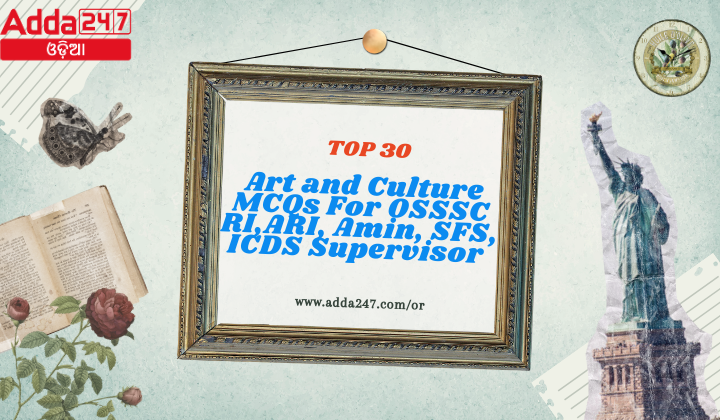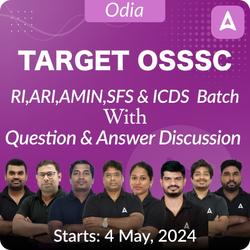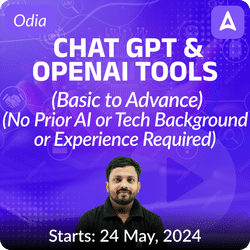Top 30 Art and Culture MCQs For OSSSC RI,ARI, Amin, SFS, ICDS Supervisor
- Which of the following techniques was used to create bronze statues in the Indus Valley Civilization?
A) Hammering and folding
B) Lost Wax technique
C) Casting in open molds
D) Electroplating
Answer: B) Lost Wax technique - The Dancing Girl, a famous bronze figure from Mohenjodaro, is characterized by:
A) Holding a pot on her head
B) A shawl draped over her left shoulder
C) Long hair tied in a bun and bangles on her left arm
D) Sitting cross-legged with animals around
Answer: C) Long hair tied in a bun and bangles on her left arm - What was the primary material used to make seals in the Indus Valley Civilization?
A) Terracotta
B) Copper
C) Steatite
D) Gold
Answer: C) Steatite - Which site is known for having bead factories in the Indus Valley Civilization?
A) Mohenjodaro
B) Harappa
C) Rakhigarhi
D) Lothal
Answer: D) Lothal - What is the significance of the Pashupati Seal found in the Indus Valley Civilization?
A) It depicts a dancing figure
B) It represents a bearded man
C) It shows a figure seated cross-legged with animals around
D) It is a symbol of fertility
Answer: C) It shows a figure seated cross-legged with animals around - What is the ‘Garbhagriha’ in a Hindu temple?
A) The entrance hall of the temple
B) The main sanctum where the deity is housed
C) The tallest spire of the temple
D) The raised platform where devotees can sit and pray
Answer: B) The main sanctum where the deity is housed - Which element of the temple architecture is typically found at the very top in North Indian temples?
A) Mandapa
B) Vahana
C) Amalaka
D) Antarala
Answer: C) Amalaka - The Nagara style of temple architecture is most commonly associated with which geographic region of India?
A) Southern India
B) Northern India
C) Eastern India
D) Western India
Answer: B) Northern India - What architectural style features a roof that rises into a vaulted chamber, resembling a wagon vault?
A) Latina
B) Phamsana
C) Valabhi
D) Vesara
Answer: C) Valabhi - The Lakshmana Temple at Khajuraho is dedicated to which deity?
A) Shiva
B) Vishnu
C) Brahma
D) Durga
Answer: B) Vishnu - Which of the following styles is NOT a category of Indo-Islamic architectural styles?
A) Imperial Style
B) Provincial Style
C) Mughal Style
D) Gothic Style
Answer: D) Gothic Style - Which of the following materials was predominantly used in the construction of Indo-Islamic architecture?
A) Concrete
B) Timber
C) Sandstone
D) Glass
Answer: C) Sandstone - The Qutub Minar, a significant example of Indo-Islamic architecture, was initiated by which ruler?
A) Alauddin Khilji
B) Qutub-ud-din Aibak
C) Humayun
D) Akbar
Answer: B) Qutub-ud-din Aibak - Which of the following is NOT a feature typically associated with Indo-Islamic architecture?
A) Arabesque
B) Calligraphy
C) Frescoes of deities
D) Geometrical patterns
Answer: C) Frescoes of deities - Which architectural element was common in the roofs of Indo-Islamic buildings?
A) Flat tiles
B) Wooden beams
C) Central dome and smaller domes
D) Steeples
Answer: C) Central dome and smaller domes - Which village in India, known for its unique form of communication, is seeking to get the UNESCO Intangible Cultural Heritage Tag?
A) Hampi
B) Khongthong
C) Kaziranga
D) Lothal
Answer: B) Khongthong - What is the main purpose of the UNESCO Intangible Cultural Heritage List?
A) To protect natural heritage sites
B) To create awareness about intangible cultural heritage
C) To fund cultural heritage projects
D) To promote tourism
Answer: B) To create awareness about intangible cultural heritage - Which of the following Indian practices was added to the UNESCO Intangible Cultural Heritage list in 2016?
A) Vedic Chanting
B) Mudiyettu
C) Yoga
D) Kalbelia
Answer: C) Yoga - When was the “Durga Puja in Kolkata” declared as an Intangible Cultural Heritage of Humanity by UNESCO?
A) 2008
B) 2016
C) 2021
D) 2023
Answer: C) 2021 - The traditional performance of Ramayana, known as “Ramlila,” was added to the UNESCO Intangible Cultural Heritage list in which year?
A) 2008
B) 2010
C) 2012
D) 2014
Answer: A) 2008 - Which of the following periods is believed by some researchers to be the origin of Yoga?
A) Gupta Period
B) Indus Valley Civilization period
C) Maurya Period
D) Mughal Period
Answer: B) Indus Valley Civilization period - Where is the first use of the word “Yoga” found?
A) Bhagavad Gita
B) Atharva Veda
C) Rig Veda
D) Sama Veda
Answer: C) Rig Veda - Which text is considered one of the earliest references to the practice of Yoga?
A) Manusmriti
B) Brihadaranyaka Upanishad
C) Arthashastra
D) Mahabharata
Answer: B) Brihadaranyaka Upanishad - What is the primary focus of Hatha Yoga as practiced in modern times?
A) Chanting and mantras
B) Ritual sacrifices
C) Physical exercises and breathing techniques
D) Philosophical discourse
Answer: C) Physical exercises and breathing techniques - Who played a significant role in resurrecting the Yoga Sutras in modern times and taking them to the West?
A) Paramhansa Yogananda
B) Ramakrishna Paramhansa
C) Swami Vivekananda
D) Ramana Maharshi
Answer: C) Swami Vivekananda - Which Chalukya king is credited with patronizing the excavation of the Badami caves?
A) Pulakesi I
B) Kirtivarman I
C) Mangalesha
D) Pulakesi II
Answer: C) Mangalesha - Which cave in Badami is known as the Vishnu Cave, and why?
A) Cave No. 1 because of the Shiva sculpture
B) Cave No. 2 due to its Jain sculptures
C) Cave No. 3 for its Buddhist paintings
D) Cave No. 4 due to the dedication of the image of Vishnu
Answer: D) Cave No. 4 due to the dedication of the image of Vishnu - Which Pallava king was known for his extensive patronage of the arts and was given titles such as ‘Vichitrachitta’ and ‘Chitrakar Puli’?
A) Narasimhavarman I
B) Rajasimha
C) Mahendravarman I
D) Simhavishnu
Answer: C) Mahendravarman I - Which period of Chola paintings is considered the original layer seen at the Brihadeswara Temple?
A) Pallava Period
B) Nayaka Period
C) Pandya Period
D) Vijayanagara Period
Answer: B) Nayaka Period - Which temple’s paintings represent the early phase of the Vijayanagara style and depict events from dynastic history and epics like the Mahabharata and Ramayana?
A) Virupaksha Temple at Hampi
B) Brihadeswara Temple at Thanjavur
C) Meenakshi Temple at Madurai
D) Kanchipuram Temple
Answer: A) Virupaksha Temple at Hampi










